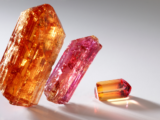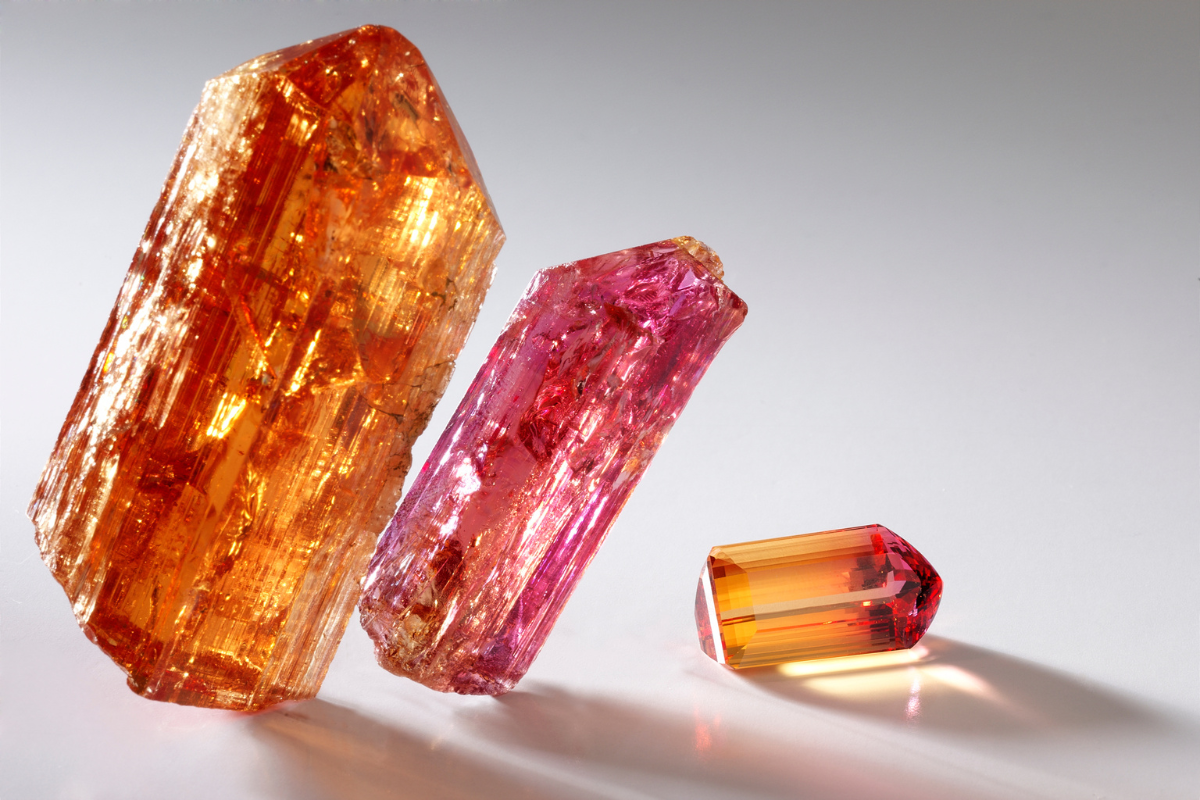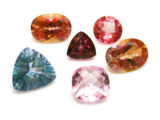Topaz occurs in pegmatites, high-temperature quartz veins and cavities in acidic rocks such as granite and rhyolite, and can be found associated with fluorite and cassiterite.
It is found in the Ural and Ilmen Mountains (Russia), the Czech Republic, Saxony, Norway, Sweden, Japan, Brazil, Mexico and the United States.

The rarest of these, the ‘imperial topaz’, was first found in Russia and then in Brazil in 1751, known as ‘Brazilian rubies’.
The first deposits were found in the Urals and were exploited during the Tsarist era.
It is mainly found in Brazil, in mines in Ouro Preto, Minas Gerais.
Due to its rarity and beauty, topaz is one of the most valued stones today. In Portugal, it is found in the Gonçalo and Guarda areas.
History of the discovery of imperial topaz
Discovered in the 18th century in the Ouro Preto region, Imperial Topaz was once very popular in Portugal, but is now rarely used.
When people talk about topaz, they usually think of the colour yellow or orange.
The term “topaz” is even mistakenly used for citrine and smoky quartz.

História da descoberta do Topázio Imperial
In fact, it was these colours that made topaz such a sought-after gemstone in the past.
Nowadays, however, it is the blue colour that makes it so popular throughout the world, and this colour, as we know, is usually artificial and usually obtained by irradiating colourless topazes.
More than two centuries ago, these colourless topazes were used in silver jewellery and were the origin of the commercial expression “minas novas” (new mines), which today has no gemological meaning.
It was therefore the yellow topazes, but especially the orange to almost red ones, that brought this mineral into the limelight of precious stones.
It was the second quarter of the 18th century and gold and diamonds were being sought in the Minas Gerais region of Brazil.
It was in the region of Ouro Preto, so called because of the nuggets of gold with a black patina found there, that the first almost red topazes were discovered.
They arrived in Portugal with great fanfare, and the most colourful specimens were nicknamed “Brazilian rubies”.
These gems were immediately incorporated into Portuguese jewellery of the time, as evidenced by pieces that still exist, such as the Custody of the Patriarchal Cathedral of Lisbon and the splendour of Senhor Santo Cristo dos Milagres in Ponta Delgada.
These show the presence of topazes of good colour and quality, along with diamonds, rubies and emeralds, reflecting the esteem in which these stones were held in Portugal.
The documentation is also rich in references to topazes, in particular the inventory of jewellery of the Dukes of Aveiro in 1759, which includes several pieces of jewellery with “Brazilian topazes”, the name by which these gemological varieties were known.
As far as nomenclature is concerned, the term “Imperial Topaz” dates back to the 19th century and may be linked to the figure of Dom Pedro II of Brazil, although there are indications that the name was given to the Russian Imperial family on the occasion of the discovery of pink and red topazes in the Urals.
The name “precious topaz” also appears for the yellow varieties. Strictly speaking, the term “imperial topaz” is the commercial name for orange to red topazes.
One of the characteristics of Imperial Topazes is the colour and brilliance they offer when illuminated by incandescent light, or especially by candlelight, giving them a particularly attractive life, which may have been the basis of their appreciation in ancient times when lit by stearin wicks.
Today, almost all imperial topaz is still produced in the Ouro Preto region, with the Vermelhão, Capão and Dom Bosco mines, for example, famous for their tonnes of material.
However, only a limited percentage is of a quality to be used as a gemstone, with orange-coloured specimens of more than 20 carats being rare and those with an intense reddish colour of more than 5 carats being even more rare.
Larger stones are more commonly yellow. These are generally clean stones and it is desirable that no internal inclusions are visible to the naked eye.
Only in the more heavily coloured specimens is there any tolerance in the purity of the stones, such is their rarity. Having perfect cleavage, care is recommended in their setting and also in their cleaning and daily use.
The colour of Imperial Topazes is generally natural, with the exception of some pink specimens which owe their colour to heat treatment.
More recently, colourless topazes coated with metallic films have appeared on the market, giving them, for example, yellow to red colours, making them difficult to detect for the less careful.
There are no known synthetic imperial topazes, but there are stones with a similar appearance, some of which are called “topaz” on the market, such as citrine and smoky quartz.
The same is sometimes true of the yellow and orange synthetic stones found, for example, in graduation rings.
In today’s Portuguese market, imperial and yellow topazes have virtually disappeared from jewellery shop windows, appearing occasionally in the windows of antique shops or auction houses, set in antique jewellery from the 18th and 19th centuries.
The popularity of topaz in Portuguese jewellery from this period may have been a motivating factor in the search for market opportunities, but this has not been verified.
It may be that new creatives will be inspired by this historical and artistic heritage to give a new direction to one of Brazil’s most interesting gemstones.
Properties of the topaz stone
Topaz is a fluorine-aluminium nesosilicate mineral with the chemical formula Al2(F,OH)2SiO4. It is widely used in jewellery and is classified as a precious stone.

Características da pedra preciosa Topázio
It is a mineral that crystallises in the orthorhombic system and its crystals are mostly prismatic with or without pyramidal faces, often with a basal pinacoid.
It has a perfect basal cleavage, so gems or other fine specimens must be held carefully to avoid cleavage faults. The cleavage is conchoidal and uneven.
When heated, yellow topaz often turns reddish-pink.
Topaz can be confused with tourmaline, andalusite, barite, beryl, quartz, danburite, apatite, synthetic spinel, chrysoberyl and kunzite.
1. Types of Topaz

There is no specific type of this gemstone apart from the Imperial, of course. They are generally distinguished by their colour, which can vary greatly. Therefore, the types of topaz are named according to the shade in which they are found.
2. Colours found
- Blue
In this case, topaz can be classified as Swiss, London or Sky, depending on its colour.

Blue topaz is a popular and sought-after stone that is difficult to find in nature, so dealers often irradiate the clear topaz and then heat it to produce a blue topaz.
Blue topazes are more popular because they resemble sea water, so most blue topaz is treated, but the price of blue topaz has decreased because it has been treated.
3. Hardness
The Mohs scale is able to quantify the hardness of minerals, i.e. their resistance to scratches, drops and other potential problems that could damage the stone. According to this index, topaz is a gemstone with a “grade” of 8, which qualifies it as an extremely solid and firm mineral.
To give you an idea, diamond is the number one most durable stone, beating out number 10 on the Mohs scale. Topaz is therefore a very hard mineral, second only to ruby and sapphire – both of which have a hardness of 9.
4. Density
This property is usually referred to as Relative Density, where the weight of the piece is compared to the weight of the same volume of water. So a material with a relative density of 3 has 3 times the weight of the same volume of water.
Topaz therefore has a density of 3.40-3.60. This value is often used to determine whether a stone is genuine or not, as this classification does not change much with the change of pieces, always following a fine line between the general aspects.
5. Refraction
Like relative density, the refractive index is often used to check whether a gemstone is genuine or not. It can also be used to determine the origin of a gemstone, the value of which varies according to its characteristics.
The gem in question has a refractive index of 1.62 and 1.63.
In short, refraction refers to the speed of light in a vacuum and in a gem, which tends to be slightly slower because the density of the gem is greater than in a vacuum.
6. Possible treatments
- Thermal – changes the colour of some yellow, orange and brown topazes to pink or red.
- Irradiation – turns some colourless topazes brown or brownish green, this is the first stage in the production of treated blue topaz, which is then heat treated to produce the blue colour in irradiated stones.
7. Stability
- Temperature – rapid heating or cooling will cause internal fractures; intense heat may change or completely lose colour.
- Daylight – some brown gemstones lose their colour when exposed to strong light.
- Chemicals – very easily attacked by acids.
8. Synthetic Topaz Stone
Like all stones sought after by sellers and consumers, topaz is also synthetically produced, some in laboratories, some synthetically and some created, but when buying topaz jewellery you should always ask about its origin and whether the stone has been treated.
The most common colours found in nature are pink and red crystals. These are the most expensive colours of natural topaz, but brown topaz can be heat-treated to produce a pink stone.
Where and how to find topaz
Brazil is a great reference point for this stone, as it is extremely rich in this mineral, especially in the state of Minas Gerais.
It is also the country that imports the most of these stones, including the Imperial Topaz, which is currently only found in Brazil.
However, the most common colours are also found in India, Australia, Germany, Mexico, Nigeria and the United States of America.
As a result, the way in which this precious stone is extracted varies from place to place, but the most common way is through gold mines.
This gem becomes even more elegant when it is used to make rings, necklaces, pendants and earrings.
These jewels are sophisticated and have a lustre that exudes elegance and fluidity, hence their high prices, but they can be made with smaller stones, reducing their cost.
The price of jewellery can vary depending on the colour of the item, the materials used and the weight of the stone.
Publicações Relacionadas
Amethyst stone - characteristics, marketing and valuation
Tourmaline: Learn about its characteristics and varieties
Diamonds have 4 basic classifications, weight, colour, purity and cut
Ruby Stone - Characteristics, Colours and Cutting
Jade stone - characteristics, colour, classification and cutting
Characteristics of the Paraíba Tourmaline, a rare gemstone
Aquamarine Stone is used in the jewellery industry - characteristics
Emerald Stone - Characteristics, varieties and quality
Tiger Eye Stone - Characteristics and Cutting
Opala é uma das mais belas pedras preciosas encontradas no Brasil
Agate Stone - Characteristics, Types, Colour and Cutting
Pindobaçu (BA), known as the capital of emeralds
Identifying a gem is a difficult task
The malachite stone is a distinctive gemstone - Features
Sapphire is the purity of nature and a symbol of honesty
Quartz Stone - Characteristics, Colours and Varieties
Jewellery made from different types of coral - Features
This post is also on:
![]() Português
Português ![]() English
English ![]() Deutsch
Deutsch ![]() Español
Español ![]() Français
Français




















